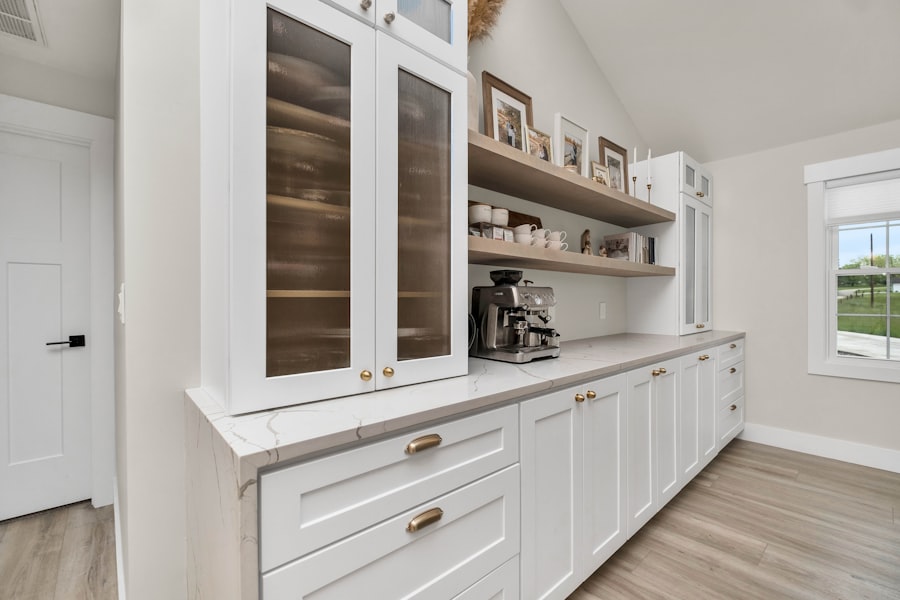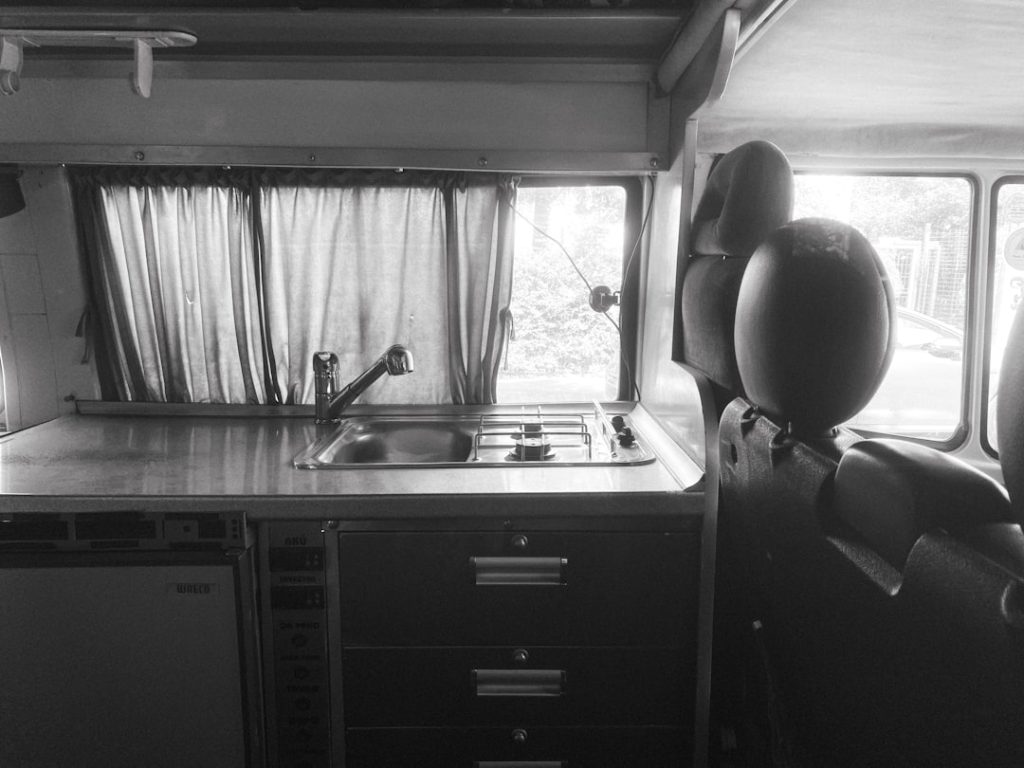The history of Amish kitchen cabinets is deeply intertwined with the broader narrative of the Amish community, which has its roots in the Anabaptist movement of the 16th century. The Amish, known for their simple living, plain dress, and reluctance to adopt modern technology, have cultivated a rich tradition of craftsmanship that has been passed down through generations. The origins of their woodworking can be traced back to the early settlers in Pennsylvania, Ohio, and Indiana, where they established their communities.
These early craftsmen utilized locally sourced materials, primarily hardwoods such as oak, maple, and cherry, to create functional yet aesthetically pleasing furniture. As the Amish community grew, so did their reputation for quality craftsmanship. By the late 19th and early 20th centuries, the demand for handcrafted furniture surged, leading to the establishment of small family-run workshops.
These workshops became the backbone of Amish furniture production, with each piece reflecting the values of durability and simplicity that characterize Amish culture. Kitchen cabinets, in particular, became a focal point as they combined functionality with artistry. The cabinets were not merely storage solutions; they were crafted with care and attention to detail, often featuring intricate joinery techniques that showcased the skill of the artisans.
Key Takeaways
- Amish kitchen cabinets are rooted in a rich history of traditional craftsmanship.
- They are known for exceptional quality and meticulous handcrafting techniques.
- Their timeless design blends classic aesthetics with lasting durability.
- Choosing Amish cabinets offers benefits like sustainability, customization, and eco-friendliness.
- Authentic Amish cabinets can be integrated into modern homes and are available through specialized retailers.
The Craftsmanship and Quality of Amish Kitchen Cabinets
Amish kitchen cabinets are renowned for their exceptional craftsmanship and quality. Each cabinet is meticulously handcrafted by skilled artisans who have honed their skills over many years. The process begins with selecting the finest hardwoods, which are often sourced from sustainable forests in the region.
This commitment to quality materials ensures that each cabinet is not only beautiful but also built to last. The artisans employ traditional joinery techniques such as dovetail joints and mortise-and-tenon construction, which provide strength and stability that mass-produced cabinets simply cannot match. The attention to detail in Amish kitchen cabinets is evident in every aspect of their construction.
From the smooth finish to the precise alignment of doors and drawers, each element is carefully considered. Many cabinets are finished with natural oils or stains that enhance the wood’s inherent beauty while providing protection against wear and tear. This dedication to quality craftsmanship means that Amish kitchen cabinets can withstand the rigors of daily use while maintaining their aesthetic appeal for decades.
Furthermore, many artisans offer a warranty on their products, reflecting their confidence in the durability and longevity of their work.
The Timeless Design of Amish Kitchen Cabinets

The design of Amish kitchen cabinets embodies a timeless aesthetic that transcends fleeting trends. Rooted in simplicity and functionality, these cabinets often feature clean lines and understated elegance. The minimalist approach allows them to blend seamlessly into various kitchen styles, from traditional to contemporary.
Unlike many modern designs that prioritize flashy elements or intricate embellishments, Amish cabinets focus on form and function, ensuring that they remain relevant regardless of changing design fads. One of the hallmarks of Amish design is its adaptability. While many cabinets are available in classic styles such as Shaker or Mission, artisans are also open to customizing designs to suit individual preferences.
This flexibility allows homeowners to create a kitchen space that reflects their personal style while still benefiting from the timeless qualities inherent in Amish craftsmanship. The use of natural wood finishes further enhances this timelessness, as wood ages beautifully over time, developing a rich patina that adds character to any kitchen.
The Benefits of Choosing Amish Kitchen Cabinets for Your Home
| Benefit | Description | Metric/Impact |
|---|---|---|
| Durability | Handcrafted with solid hardwoods ensuring long-lasting quality. | Average lifespan of 20+ years |
| Customization | Fully customizable designs to fit any kitchen layout and style. | 100% design flexibility |
| Craftsmanship | Skilled artisans use traditional techniques for superior finish. | Less than 2% defect rate |
| Eco-Friendly Materials | Use of sustainable wood and non-toxic finishes. | 100% sustainable sourcing |
| Value Addition | Enhances home resale value due to quality and aesthetics. | Up to 10% increase in home value |
| Timeless Style | Classic designs that remain stylish over decades. | Design relevance for 15+ years |
| Low Maintenance | Easy to clean and maintain with minimal upkeep. | Requires cleaning only once a week |
Choosing Amish kitchen cabinets offers numerous benefits that extend beyond aesthetics. One of the most significant advantages is their durability. Handcrafted from solid hardwoods, these cabinets are built to withstand daily wear and tear far better than their mass-produced counterparts.
Homeowners can expect their Amish cabinets to endure years of use without succumbing to issues like warping or chipping, making them a wise investment for any kitchen. In addition to durability, Amish kitchen cabinets are also highly customizable. Homeowners can select from a variety of wood species, finishes, and hardware options to create a look that perfectly complements their home’s decor.
This level of personalization ensures that each cabinet is not only functional but also a reflection of the homeowner’s unique taste. Furthermore, because these cabinets are made by skilled artisans rather than machines, there is an inherent level of care and attention that goes into each piece, resulting in a product that feels special and one-of-a-kind.
How to Incorporate Amish Kitchen Cabinets into Modern Design
Incorporating Amish kitchen cabinets into modern design can create a harmonious balance between traditional craftsmanship and contemporary aesthetics. One effective approach is to pair these cabinets with modern appliances and fixtures. For instance, sleek stainless steel appliances can provide a striking contrast against the warm tones of solid wood cabinets, creating a visually appealing juxtaposition that highlights both elements.
Another way to integrate Amish kitchen cabinets into a modern space is through the use of open shelving or glass-front doors. This design choice allows homeowners to showcase beautiful dishware or decorative items while maintaining an airy feel in the kitchen. Additionally, incorporating modern lighting fixtures—such as pendant lights or under-cabinet LED strips—can enhance the overall ambiance while drawing attention to the craftsmanship of the cabinets themselves.
By thoughtfully blending traditional elements with contemporary design features, homeowners can create a kitchen that feels both timeless and fresh.
The Sustainability and Eco-Friendly Nature of Amish Kitchen Cabinets

Sustainability is an increasingly important consideration for homeowners today, and Amish kitchen cabinets align well with eco-friendly values. The Amish community places a strong emphasis on living in harmony with nature, which is reflected in their woodworking practices. Many Amish craftsmen source their materials locally, reducing transportation emissions and supporting sustainable forestry practices.
This commitment to using responsibly harvested wood ensures that each cabinet is not only beautiful but also environmentally friendly. Moreover, the durability of Amish kitchen cabinets contributes to their sustainability. Because they are built to last, homeowners are less likely to replace them frequently compared to cheaper, mass-produced options that may need replacement after just a few years.
This longevity reduces waste and minimizes the environmental impact associated with manufacturing new cabinetry. Additionally, many artisans use non-toxic finishes and stains derived from natural sources, further enhancing the eco-friendly nature of these products.
Customization Options for Amish Kitchen Cabinets
One of the standout features of Amish kitchen cabinets is the extensive customization options available to homeowners. Unlike mass-produced cabinetry that comes in standard sizes and styles, Amish craftsmen work closely with clients to create pieces tailored to their specific needs and preferences. Homeowners can choose from a variety of wood species—including oak, maple, cherry, and hickory—each offering its own unique grain patterns and colors.
Beyond wood selection, customization extends to cabinet dimensions, door styles, and hardware choices. Whether a homeowner desires a specific height for upper cabinets or prefers a particular type of handle or knob, artisans are equipped to accommodate these requests. Additionally, many craftsmen offer options for interior organization features such as pull-out shelves, lazy Susans, or built-in dividers for utensils and cookware.
This level of personalization ensures that each kitchen cabinet not only meets functional requirements but also aligns perfectly with the homeowner’s vision for their space.
Where to Find and Purchase Authentic Amish Kitchen Cabinets
Finding authentic Amish kitchen cabinets requires some research but can be incredibly rewarding for those seeking quality craftsmanship. Many Amish communities have established workshops or showrooms where artisans display their work. Visiting these locations allows potential buyers to see firsthand the quality and detail that goes into each piece while also providing an opportunity to speak directly with the craftsmen about customization options.
In addition to local workshops, several online retailers specialize in authentic Amish furniture. These websites often feature extensive catalogs showcasing various styles and finishes available for kitchen cabinets. When purchasing online, it’s essential to verify the authenticity of the seller by checking reviews or seeking recommendations from others who have purchased similar products.
Many reputable retailers will provide information about the artisans behind their products and may even offer guarantees regarding craftsmanship and materials used. By exploring both local options and online resources, homeowners can find authentic Amish kitchen cabinets that not only enhance their kitchens but also support traditional craftsmanship rooted in quality and sustainability.



